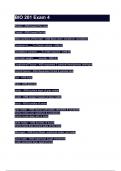BIO 201 Exam 4
Rostral - ANS-toward the nose
Caudal - ANS-toward the tail
Major portions of the brain - ANS-Brain stem, Cerebrum, cerebellum
Cerebrum is ___% of brain volume - ANS-83
Cerebellum contains ___% of the neurons - ANS-50
The brain weighs ___ pounds - ANS-3.5
Longitudinal Fissure - ANS-separates 2 cerebral hemispheres (left/right)
Central Sulcus - ANS-Separates frontal & parietal lobe
Gyri - ANS-folds
Sulci - ANS-grooves
cortex - ANS-surface layer of gray matter
nuclei - ANS-deeper masses of gray matter
tracts - ANS-bundles of axons
gray matter - ANS-neuron cell bodies, dendrites & synapses
-forms cortex over cerebrum & cerebellum
-forms nuclei deep with in brain
white matter - ANS-bundles of axons
-forms tracts that connect parts of the brain
Meninges - ANS-Dura Mater, arachnoid mater, pia mater
Dura mater - ANS-outermost, tough membrane
-outer periosteal layer against bone
,-inner meningeal layer
-subdural space (below dura mater)
-where separated from inner meningeal layer forms dural venous sinusesdraining blood
from brain
supportive structures formed by dura mater - ANS-falx cerebri, falx cerebelli & tentorium
cerebelli
Arachnoid mater - ANS-spider web filamentous layer
Pia mater - ANS-a thin vascular layer adherent to contours of brain
Meningitis - ANS-Inflammation of the meninges
-bacterial & virus invasion of the CNS by way of the nose & throat
-signs: high fever, stiff neck, drowsiness & intense headache which could lead to coma
-diagnose by examining the CSF fluid for bacteria
Lumbar puncture - ANS-(spinal tap) check spinal fluid
-draws fluid from subarachnoid space between two lumbar vertebrae
Lateral ventricles - ANS-found inside the cerebral hemispheres
Third ventricle - ANS-single vertical space under corpus callosum
Cerebral aqueduct - ANS-runs through the midbrain (connects 3rd & 4th ventricle)
Central canal - ANS-runs down through spinal cord
Ventricles - ANS-Internal chambers within the CNS
-lined with ependymal cells & containing choroid plexus of capillaries that produce CSF
Cerebrospinal fluid - ANS-clear liquid that fills ventricles & canals & bathes in its
external surface (in subarachnoid space)
The brain produces & absorbs ___ml/day of CSF - ANS-500
Functions of CSF - ANS-Buoyancy: floats brain so its neutrally buoyant
Protection: cushions from hitting inside of skull
Chemical stability: rinses away wastes
, CSF escapes from ___ to surround the brain & is absorbed by ___ into venous sinus -
ANS-4th ventricle/ arachnoid villi
Circumventricular organs... - ANS-...in 3rd & 4th ventricles are breaks in the barrier
where blood has direct access
-monitoring of glucose, pH, osmolarity & other variations
-allows route for HIV to invade the brain
Blood-brain & Blood-CSF barriers - ANS-Tightly joined endothelium
-permeable to lipid-soluble materials (alcohol, nicotine, O2, CO2 & anesthetics)
Hindbrain - ANS-Medulla Oblongata, Pons, Cerebellum
Medulla Oblongata - ANS-contains cardiac, vasomotor, respiratory & reflex centers
which adjust heart rate but also control coughing & sneezing, etc.
-3 cm extension of spinal cord
-ascending & descending nerve tracts
-Nuclei of sensory & motor nerves (IX,X,XI,XII)
Cardiac Center (Medulla) - ANS-adjusts heart rate & force
Vasomotor Center (Medulla) - ANS-adjusts blood vessel diameter
Respiratory Center (Medulla) - ANS-controls rate & depth of breathing
Reflex Center (Medulla) - ANS-coughing, sneezing, gagging, swallowing, vomiting,
salivation, sweating, movements of tongue & head
Pons - ANS-Bulge in the brainstem
-Rostral to the medulla
-Ascending sensory tracts, descending motor tracks
-pathways in & out of cerebellum
-nuclei concerned with sleep, hearing, balance, taste, eye movements, facial
expression, facial sensation, respiration, swallowing, bladder control & posture (CN V,
VI, VII, VIII)
Cerebellum - ANS-Evaluates sensory input (spatial perception), timekeeping center
(predicts movements of objects), distinguish pitch & similar sounding words, planning &
scheduling tasks.
-helps learn motor skills (memory)




